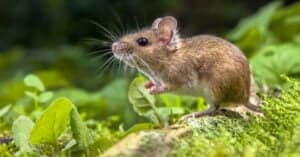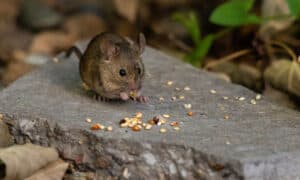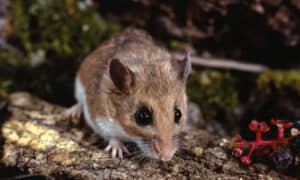Cuddly, adorable, and super-soft, the domestic chinchilla is a fairly popular exotic pet. Like many other domesticated rodents commonly kept as pets, chinchillas are fairly low-maintenance and fascinating to observe thanks to their delightfully playful and curious temperaments. But is it the right pet for you? Furthermore, what kind of diet and enclosure setup do these unique creatures need to thrive in captivity?
Read on as we take a closer look at the chinchilla. We’ll go over how and why it became so popular in the pet trade, how to decide if it’s the right companion for you, and what you’ll need to do to make sure your pet chinchilla is happy, healthy, and thriving in your care.
What Are Chinchillas?
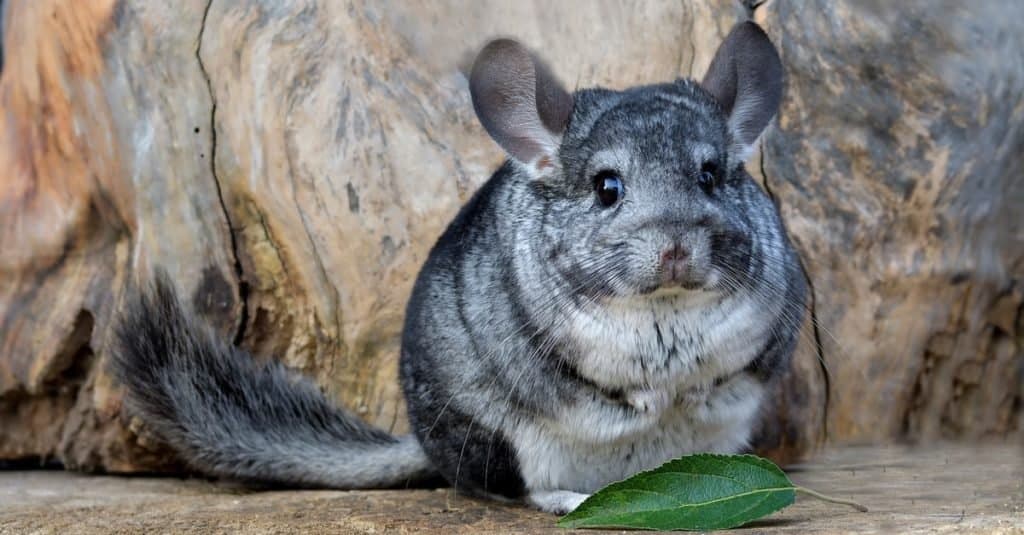
The chinchilla originally rose to popularity thanks to its soft fur, but today, it is a common exotic pet.
©ATTILA Barsan/Shutterstock.com
Chinchillas are small rodents classified within the Chinchillidae family. Today, this group is very small, as most of its members aside from chinchillas and viscachas have long gone extinct. They are fairly closely related to guinea pigs, capybaras, and the similarly-named but distinct chinchilla rats.
There are actually two main species of chinchillas, the long-tailed chinchilla, Chinchilla lanigera, and the short-tailed chinchilla, Chinchilla chinchilla. Both are very similar in appearance aside from the length of their tails and the size of their ears.
In the wild, both species are endangered due to habitat loss and being hunted by humans for their ultra-soft fur. Today’s domestic pet chinchilla is a descendant of both species and was produced by careful, repeated crossbreeding of the two.
Unfortunately, the wild short-tailed variety is rapidly nearing extinction. However, today, chinchillas are almost exclusively bred to be sold as exotic pets rather than for their fur as they were in the past. This has greatly increased their numbers in captivity.
Both main species of chinchillas are native to the rocky hills and Andes mountains of Chile, Argentina, and Peru. Its name comes from the Peruvian Chincha people who lived in the same region and heavily utilized its luxurious, dense fur.
Chinchillas are highly social animals. They typically live in large groups, or herds, in the wild. These groups can have anywhere from a dozen or so to more than 100 individuals. Living in groups provides them with enrichment and helps keep them safe from various predators.
In addition to becoming popular pets over the past 50 years or so, chinchillas also have been helpful for medical research, as they have exceptional hearing.
Do Chinchillas Make Good Pets?
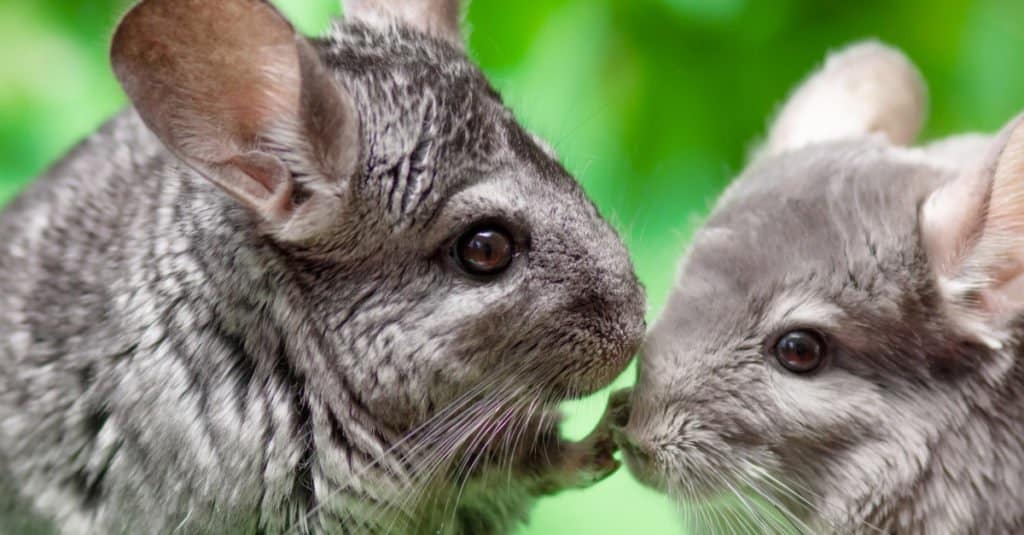
Pet chinchillas can live alone, but they greatly enjoy and benefit from living in pairs or small groups.
©Creatopic/Shutterstock.com
Chinchillas can make great pets for adults and older, responsible children. They are fairly low-maintenance, not particularly expensive to care for, and readily available from various pet shops and breeders. Though they can be shy and anxious at first, they tame easily and develop close bonds with their owners.
In most areas, there are currently no specific legal restrictions on the sale and ownership of chinchillas. A single chinchilla can be purchased for as little as $150, though this price sometimes fluctuates depending on the current supply and demand. They can live alone, but they fare especially well in pairs, as they are very social and playful.
As far as handleability goes, chinchillas tolerate and even enjoy being held and petted, provided you spend some time carefully socializing them while they’re young. They’re also a lot of fun to observe in captivity and are quiet, not particularly messy or smelly, and generally very docile.
In short, chinchillas are great exotic pets and do well in captivity. Still, like any pet, they require a specific diet and a particular enclosure setup in order to thrive. Thankfully, these are both relatively inexpensive and uncomplicated. With optimal care, the typical pet chinchilla can live for 10 to 15+ years.
What Do Chinchillas Eat?
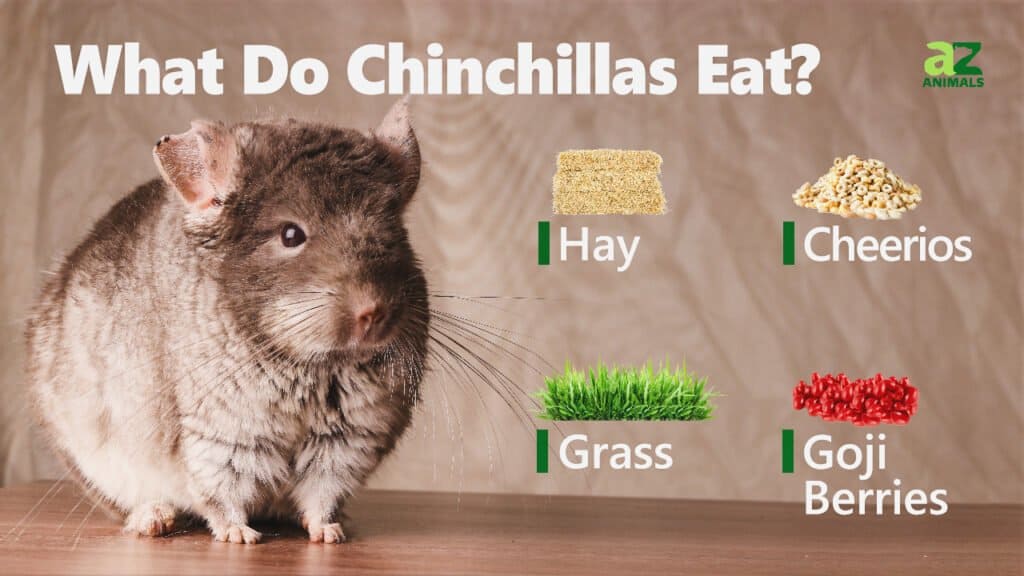
Chinchillas are technically omnivores, as they sometimes eat insects in the wild, but they primarily feed on various types of vegetation. A wide variety of safe grasses, twigs, flowers, leaves, vegetables, and fruits are all typical fare for both wild and pet chinchillas.
Although they don’t necessarily need vitamin supplements, their diets should ideally have plenty of fiber, calcium, sodium, and phosphorus while also being low in fat and carbs.
The bulk of any pet chinchilla’s diet should be made up of hays like orchard grass, oat hay, and timothy hay. Additionally, commercial pellet food that is fortified with essential vitamins and nutrients should also make up a large portion of their meals.
A constant supply of hay, pellets, and other vegetation will also provide chinchillas with a means of filing down their constantly-growing teeth. This way, they won’t destructively gnaw on their enclosure or other inedible objects.
Aside from these staple foods, various nuts, cereals, and dried fruits make great treats. However, because these tasty snacks contain high amounts of sugar and fat, your chinchilla should only eat them on occasion in small amounts.
What Do Pet Chinchillas Need in Captivity?
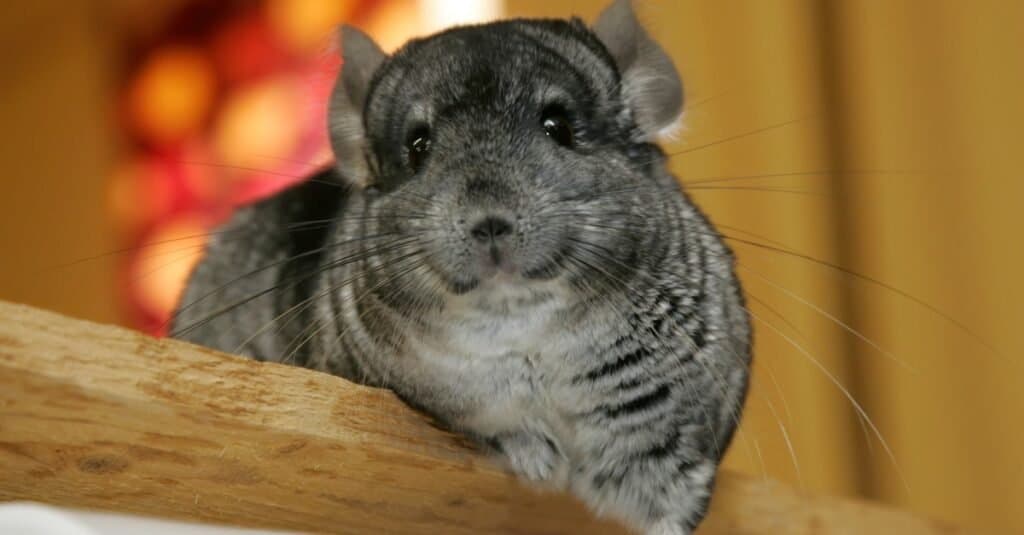
Chinchillas aren’t particularly demanding pets, and they are a delight to observe.
©AJSTUDIO PHOTOGRAPHY/Shutterstock.com
Chinchillas are moderately low-maintenance pets, though they must live in fairly large, secure enclosures. Your chinchilla should not be able to freely run around your home unsupervised, as they are very curious animals and prone to destructive chewing and scratching.
Tall, wide, multi-level enclosures are ideal for pet chinchillas, as they are interesting and enriching and encourage your pet to actively explore their environment. Make sure the enclosure has no holes, weak points, or openings that could provide a means of escape.
The floor of the enclosure should have soft, absorbent bedding like fleece liners, pine shavings, or paper shavings. A durable, chew-proof water bottle with cool, fresh water should always be available for drinking. Toys like wheels, colorful balls, and lots of branches to chew on will keep your chinchilla busy, happy, and thriving.
As far as other decorations go, a cozy hide or two will provide your pet chinchilla with a quiet, dark spot to rest and hide away when they’re feeling shy. The enclosure also needs a small tray for your chinchilla to take dust baths. Most pet shops sell chinchilla dust made of clay and volcanic ash. Your chinchilla will often roll around in this dust to keep their coat clean and healthy.
Generally, chinchillas don’t require any kind of specific heating or lighting. They are most comfortable at around room temperature, or between 60F and 75F. Humidity should be moderate at around 50% to 60%. Keep in mind, though, that chinchilla fur is very dense, and chinchillas can’t sweat or regulate their body temperature very well. This means they can quickly overheat at temperatures above 80F.
The photo featured at the top of this post is © Creatopic/Shutterstock.com
Thank you for reading! Have some feedback for us? Contact the AZ Animals editorial team.



